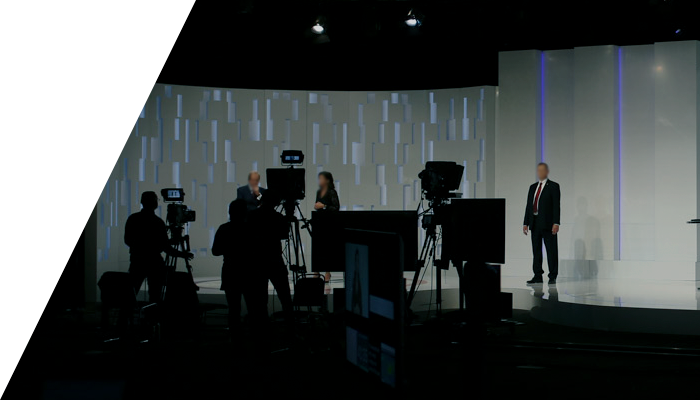Your professional webcasts look like they were produced by amateurs!
Every element of your webcasts represents you. It's important to ensure that your webcast experience is professional and respects your company's brand image and values. Easier said than done? You think your virtual events are not up to par? Take a look at this article and discover 8 reasons why.
1. Tool not adapted to webcasting
There are many video communication tools for businesses. These tools meet different needs and can be separated into two main categories:
- meeting tools (e.g. Microsoft Teams);
- webcasting tools (e.g. Digicast-signed tools).
For virtual events with large numbers of people (50 to 100,000 participants!) or with advanced functionality, the ideal solution is to choose a webcasting tool. These are designed specifically to meet the needs of professional presentations. Since meeting tools were not designed to meet these needs, they do not offer the same powerful features such as simultaneous translation, broadcast archiving, interface customization, a separate window for your PowerPoint presentation synchronized with speech or detailed data analysis.
An efficient webcasting tool will allow you to track and analyze your broadcast data in real time and keep it at the end of your events. You'll know what's working and what's not, when attendees logged in and out, their languages, whether they participated in votes and more.
2. Inadequate synchronized presentation
At your webcast events, whether it's a general meeting, a gala or a conference, you want to capture and keep the attention of your audience from start to finish. So you accompany your webcasts with videos or a PowerPoint-style presentation. (These are a must these days!) However, if your video doesn't appear when you want it to, or if your presentation contains
However, if your video doesn't appear when you want it to or your presentation contains spelling mistakes, your audience's attention and your credibility take a hit.
3. Limiting platform
To deliver a quality experience that your audience will remember, you need a platform that can accommodate all your needs. Whether it's interactivity, cybersecurity or connectivity needs, many platforms now offer a wide variety of features:
- authentication ;
- registration ;
- secure voting ;
- timed questionnaire ;
- polling ;
- live results viewing ;
- live speaking;
- and more.
The world of webcasting is rapidly evolving and many trends are emerging and standing out. For your next virtual event, don't forget to consider the trends in the webcasting industry.
4. Poor sound or image quality
Discrepancies between sound and image, poor framing, lack of light or low volume... Several factors can irritate or annoy participants during your webcasts. The rendering of your webcast has a direct impact on the public's perception of your company. Why not opt for a real "news" or "talk show" style presentation? Show your audience that they are attending an important event; this is not a simple Facetime call! Whether it's from your own premises or in a studio, always make sure you use quality equipment to get a professional result.
5. No support for participants
Attendee satisfaction, whether they are employees, members or customers, is a priority! If you were hosting an in-person event, you would have people on hand to assist attendees and offer help if there were any problems. The same is true for virtual or hybrid events.
Consider offering technical support to your audience. Some people are not comfortable with new technology. For example, some attendees may need help logging into the event. Knowing that experts are there when needed will give your audience confidence. They will know that you are putting them first.
6. Lack of adaptability
For an optimal user experience, you need to opt for a webcasting tool that is designed to adapt to each participant's device. Your webcast must be ergonomic on a mobile device as well as on a tablet or a computer. This is called "responsive design". This will avoid many frustrations for some participants.
7. Clumsy master of ceremonies
The role of the master of ceremonies is very important. This person leads your event and becomes a sort of guide for the participants and speakers. They represent your company throughout the webcast.
The master or mistress of ceremonies must be aware of what is going on and guide the flow of the event, whether it is by sharing information with the audience, introducing speakers or leading activities or question periods. It is essential that he or she is aware of the details and flow of the event throughout the webcast. This can be done through video feedback and real-time feedback and follow-up information from the event moderators.
Your master of ceremonies can deliver a performance that matches your organization, respects your values and shows your professionalism.
8. Lack of overall flow
Unexpected breaks and untimely delays are commonplace in the event industry. However, this does not excuse them! Think, for example, of a speaker having difficulties with the webcasting platform, an interrupted connection, a public chat distracting the audience or a video that does not start... Unfortunately, several elements can make your presentation difficult to follow and cause you to lose the attention of the participants.
In short, there are many reasons why webcasts can result in a disappointing execution and overall experience. For your webcast corporate communications, however, you have everything to gain by delivering professional and impactful webcasts. How do you want the public to remember your event and your company? Relevant and interesting communications that reflect your image will help you achieve your organizational goals.



